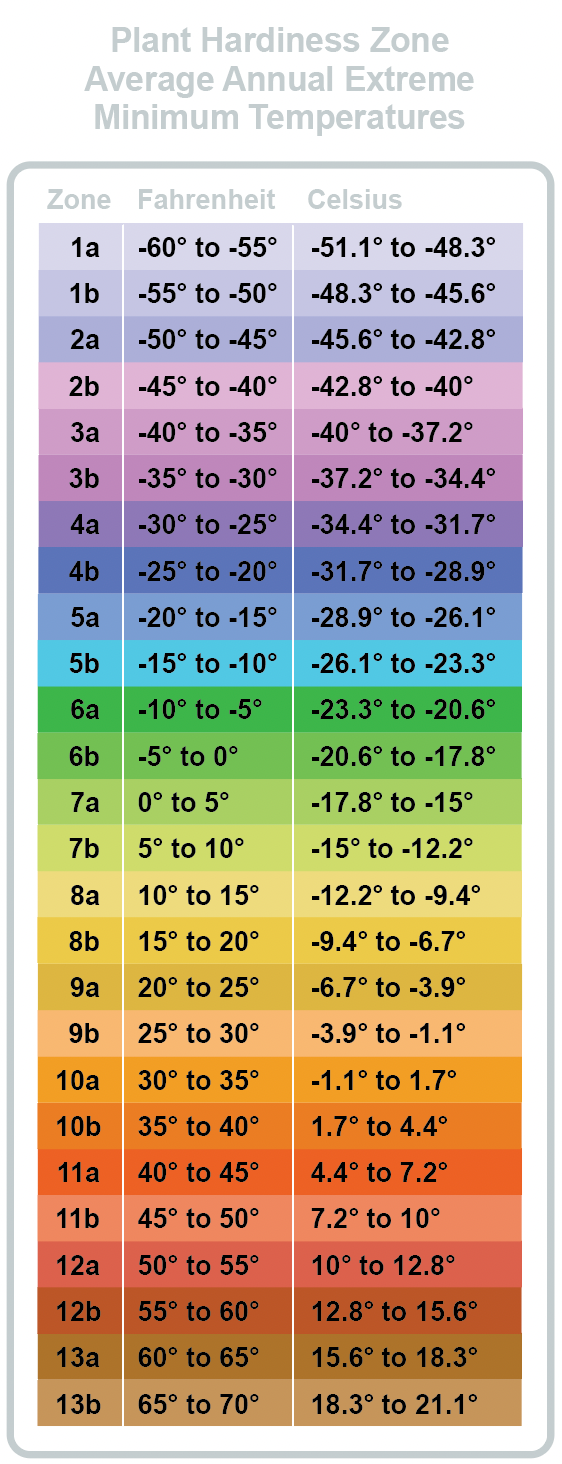Perfect for beginner gardeners and beyond, Swan’s interactive Planting Zone Map gives you the information you need to set up your garden for success from the get-go. This includes helping you discover your plant hardiness zone, which tells you which plants will do best in your garden based on the zip code (climate) you live in, as well as your seasonal frost dates for planting and harvesting at just the right time. It also provides your nearest soil-testing location to ensure your soil is in tip-top shape for planting.
Read on to learn more about plant hardiness zones, frost dates and soil testing, and to find instructions on how to use the map most effectively. Happy gardening from your friends at Swan!
What Is a Plant Hardiness Zone?
A plant hardiness zone (or planting zone) is a geographic area defined as having a certain average annual minimum temperature, a factor revelant to the survival of many plants. These plant hardiness zones were first developed by the United States Department of Agriculture (USDA) to aid U.S. gardeners and landscapers in choosing plants that would most likely survive the coldest temperatures in their area. The USDA’s planting zone system is the most widely used to date, and it’s the one that Swan has based its map on.
The 13 U.S. Plant Hardiness Zones
The USDA has divided the country, including Alaska, Hawaii and Puerto Rico, into 13 plant hardiness zones. For example, Zone 1 includes areas up north such as Fairbanks, Alaska, and the northern islands of Canada; Zone 11 includes most of Hawaii; and Zones 12 and 13 are in Puerto Rico. Each of the 13 zones are then divided into two number/letter-combination growing zones for greater accuracy, as follows:
Zone 1a Zone 1b Zone 2a Zone 2b Zone 3a Zone 3b
Zone 4a Zone 4b Zone 5a Zone 5b Zone 6a Zone 6b
Zone 7a Zone 7b Zone 8a Zone 8b Zone 9a Zone 9b
Zone 10a Zone 10b Zone 11a Zone 11 Zone 12a Zone 12b
Zone 13a Zone 13b
The Zones’ Average Annual Extreme Minimum Temperatures
As illustrated in the chart below, each of these 13 plant hardiness zones has an average annual extreme minimum temperature range of 10 degrees. For example, Zone 1 (1a and 1b) has a combined average annual extreme minimum temperature range of -60° F to -50° F, while the range for Zone 13 (13a and 13b) is 60° F to 70° F.
Each planting zone is also generally 10 degrees warmer (or colder) in an average winter than the adjacent zone, with the higher the zone number, the warmer the climate.

To understand this chart more fully in relation to gardening, if a plant is “hardy to Zone 5” for instance, and your garden is in Zone 6, that plant will survive the coldest temperature in your area. However, if you live in Zones 1, 2, 3 or 4, your average annual extreme minimum temperature will be too cold to grow a Zone 5 plant in your garden.
Most seeds and plants today come with a label listing their plant hardiness zone, so be sure to look for it!
How to Find Your Plant Hardiness Zone
To discover your plant hardiness zone (or planting zone), enter your zip code in the “Enter Zip Code” box in the blue bar along the top of Swan’s Interactive Planting Zone Map. The map will then zoom into your particular zip code and highlight the location. You will see your planting zone by zip code appear in the white box, along with the average annual extreme minimum temperature in your area. (There’s also a map legend that includes the planting zone number and letter combinations, color-coded to correspond with the map, which you might also find helpful.)
You’ll also find additional useful gardening information in the white box, including the last spring and first fall frost dates in your zip code, as well as a link to find your local extension office for soil testing.
Frost Dates
Knowing the last frost date for your area is important so you don’t put your plants out prematurely and have them die from the cold. Similarly, the first frost date is also important so that you harvest your plants or move them indoors before winter weather sets in.
Soil Testing
Healthy soil is also essential to the success of your garden. A good rule of thumb is to have your soil tested before planting to determine its needs. Try purchasing a soil-testing kit, or send a sample to your local extension office; then amend soil health as suggested. To find your local extension office, simply click the Soil-Testing Extension Office link in the white box on the map and then enter your zip code on the website that appears.

We hope you find Swan’s Interactive Planting Zone Map a helpful tool as you begin or continue on in your gardening journey. Check back again as we plan to add to the resources the map provides. Also, be sure to check out the Articles section on our website for expert information on topics such as gardening, hoses and watering, as well as all the latest Swan news.




